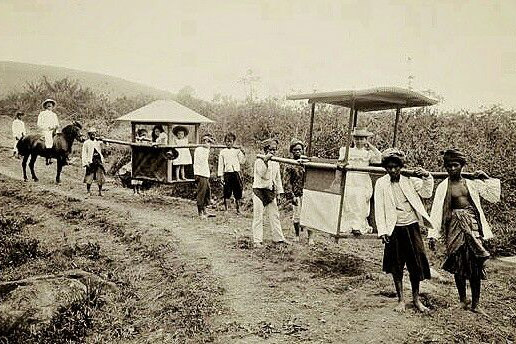Britain used all kinds of means to mobilize the much-needed manpower for the opening of a new sugar factory. This includes coercion and deception.
The doll in the form of a lion was climbed by a boy who looked innocent. Four men carried the stuffed lion with bamboo bars on their backs. The rhythm of the drums, kempul, gongs, and trumpets shouted loudly. The bearer of the coffin in the form of a lion or Sisingaan is usually more than one group. They danced and acted performing sloppy movements, sometimes acrobatic.
Sisingaan, according to T Dibyo Harsono, in the book Bunga Rampai History and Culture (West Java) (2010) is a typical art of Subang Regency which is characterized by the forms of coffins or dolls that resemble lions. The coffin was carried by a group of dancers who performed various attractions to the accompaniment of traditional music.
Interestingly, Sisingaan in Subang has a strong historical background. Why was a shape resembling a lion made? Why should it be carried or carried while being paraded? Why should a small child sit on Sisingaan? Why does the accompaniment use gongs, taps, drums, and flutes?
All of these questions were elaborated by the cultural researcher who graduated from Anthropology at Gajah Mada University in a book published by the Bandung Traditional Values and History Preservation Center sponsored by the Ministry of Culture and Tourism.
Subang Special Arts
Sisingaan, which is also commonly called Gotong Singa, Singa Ungkleuk, Lion Depok, Kuda Ungkleuk, Pergosi, or Odong-odong is indeed very popular in the Subang Regency area. Because there are so many variations of names and art groups, it is necessary to make an agreement to find a common understanding.
Suwardi Alamsyah, from the Bandung Cultural Values Preservation Agency (BPNB), in his article on Sisingaan as a traditional art in Subang Regency, reviews the process. The first to make efforts to unite the various kinds of procession was the Regent of Subang for the period 1978-1988, namely Ir Sukanda Kartasasmita. He even needed to hold a special seminar on Sisingaan in 1989 to seek agreement and standardize this typical art of Subang Regency.
Returning to T Dibyo Harsono’s book, who is currently still listed as an ASN at BPNB Bandung, he traces the emergence of Sisingaan art since the early 19th century. At that time, the Subang area and its surroundings were part of an area called “Pamanoekan en Tjiasemlanden” or the area which is between Pamanukan and Ciasem. Its abbreviation in English is P&T Lands.
Why is the name of the region abbreviated in English? Dibyo explained that the context of that era from 1811 to 1816 was the joint venture between the Dutch and the British in West Java. As the political ruler was the Netherlands, while the economic control was handed over (in part) to the British.
The book Sugar Steam and Steel , by Roger Knight (2014), provides an explanation of why economic control, aka the opening of new industrial estates, was handed over to Britain. The answer was the issue of the efficiency of the Dutch government’s budget by bringing in investment in the sugar industry, which had good prospects at that time. It is said that the massive investment in the sugar industry in the early 19th century formed the cities in Java from west to east.

British master in Subang which Sisingaan insinuated. Photo: National Archives
Insinuating British Colonialism
The P&T area, or the Subang area and its surroundings, which is located to the north of Mount Tangkuban Parahu, is also known as the Doble Bestuur area or two special areas. Why special? Because it is planned as a place for plantation development as well as the sugar industry by using the latest technology and machines.
At that time, according to Dibyo, the people of Subang were introduced to two symbols of rulers. The first is the crown which is the symbol of the Netherlands. The second is the three lions which is a symbol of British rule. It was under British rule that the people of Subang came under strong economic pressure. Britain used all kinds of means to mobilize the much-needed manpower for the opening of a new sugar factory. This includes coercion and deception.
At this point, the people of Subang, even though they are powerless in the face of coercion, are resisting as best they can. When physical resistance is not possible, the Subang people fight in the form of culture. Its form is Sisingaan art.
Imagine, the British colonial industrial power which is symbolized by the Lion, in the imagination of the Subang people, can be conquered by a boy who can ride it. Sundanese art, which is shared by many other regions, has several ways of ‘resisting’. The first is cross or express opinions but not directly. The second is satire or telling something irony or satire. The third is siloka or making symbols. And the fifth is sasmita or giving meaningful examples.
Subang people or cultural arts actors in Subang express their views through satire. The imposition of British colonialism that made them suffer they satirized with Sisingaan. Sisingaan art is a way for the Subang people to rebel against the invaders who are manifested as lions. This lion colonized because he stepped on, or carried on the suffering of the Subang people who were considered stupid and poor. The Subang people hope that one day the younger generation, which is symbolized by the child riding Sisingaan, will be able to rise up to repel the invaders.